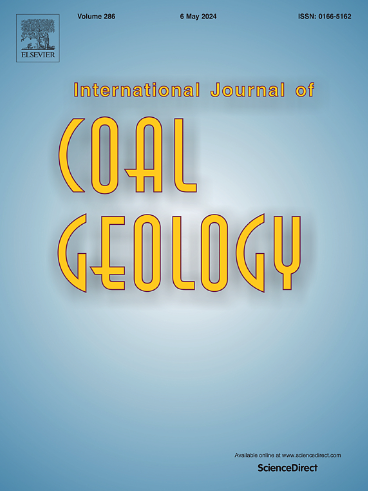Organic matter accumulation in Barremian marine black shales of the Qiangtang Basin, China
IF 5.7
2区 工程技术
Q2 ENERGY & FUELS
引用次数: 0
Abstract
Barremian organic-rich black shales are significant source rocks in the eastern Tethyan Qiangtang Basin. Based on petrological, inorganic and organic geochemistry analyses, the black shales are divided into three units from bottom to top. Unit 1 micritic limestones exhibit high total organic carbon (TOC) contents and Type II₂ kerogen, indicating a mixture of marine microalgae and land plants. Unit 2 black shales show the highest TOC contents, predominantly Type II₁ kerogen suggesting marine microalgal source. In contrast, Unit 3 marls have relatively low TOC contents, Type II₂ kerogen, indicating mixed terrestrial and marine OM sources. The black shales show a low organic maturity, and the hydrocarbon generation potential of the black shale and micritic limestone samples is substantially higher than that of the marl samples. Palaeoredox proxies indicate that Unit 1 deposited under dysoxic-anoxic conditions, and Unit 2 formed under anoxic-euxinic conditions, while Unit 3 deposited under oxic-suboxic conditions. Primary productivity proxies reflect high productivity in Units 1 and 2, and low productivity in Unit 3. Rb/K and total sulfur/TOC ratios suggest brackish environment in Units 1 and 2 and brackish or seawater condition in Unit 3. Hydrothermal activity during Unit 2 black shale deposition provided essential nutrients for phytoplankton in the photic zone, leading to high OM production. Upwelling/restriction proxies imply deposition under moderately restricted conditions for Unit 1, strongly restricted conditions for Unit 2, and upwelling/weakly restricted conditions for Unit 3. Palynological analysis indicates a warm, semi-humid to humid temperate climate during deposition of Units 1 and 2, contrasting with a hot, arid to semi-arid climate during Unit 3 marl deposition. OM accumulation of Unit 1 micritic limestone was primarily controlled by stratified dysoxic-anoxic conditions, high primary productivity, warm humid/semi-humid climate, and moderate watermass restriction. For Unit 2 black shale, the main controlling factors were stratified anoxic-euxinic environment, warm humid temperate climate, strongly restricted water condition, and intermittent strong hydrothermal activity. During Unit 3 marl deposition, low primary productivity, an oxygen-rich water environment leading to OM degradation, combined with a hot arid/semi-arid climate, resulted in organic-lean deposition.
羌塘盆地巴雷米亚系海相黑色页岩有机质富集特征
巴雷米亚系富有机质黑色页岩是特提斯—羌塘盆地东部重要的烃源岩。根据岩石学、无机和有机地球化学分析,将黑色页岩从下向上划分为3个单元。1单元泥晶灰岩总有机碳(TOC)含量高,ⅱ型干酪根含量高,为海洋微藻和陆生植物的混合体。2号单元黑色页岩TOC含量最高,以II型干酪根为主,表明其来源为海洋微藻。3单元灰岩TOC含量相对较低,为ⅱ型干酪根,表明陆相和海相有机质混合源。黑色页岩有机质成熟度较低,黑色页岩和泥晶灰岩的生烃潜力明显高于泥灰岩。古氧化还原指标表明,1单元沉积于缺氧-缺氧条件下,2单元沉积于缺氧-缺氧条件下,3单元沉积于缺氧-缺氧条件下。初级生产率代理反映单元1和单元2的高生产率,单元3的低生产率。Rb/K和总硫/TOC比值表明1号和2号机组的环境为微咸环境,而3号机组的环境为微咸环境或海水环境。第2单元黑色页岩沉积期间的热液活动为光带浮游植物提供了必需的营养物质,导致OM产量高。上升流/限制代理意味着单元1在中等限制条件下沉积,单元2在强烈限制条件下沉积,单元3在上升流/弱限制条件下沉积。孢粉学分析表明,单元1和单元2沉积时期为温暖、半湿润至湿润温带气候,而单元3泥灰岩沉积时期为炎热、干旱至半干旱气候。1号泥晶灰岩OM的成藏主要受层状缺氧缺氧条件、高初级生产力、暖湿/半湿气候和适度水团限制的控制。2单元黑色页岩的主要控制因素为层状缺氧-缺氧环境、温暖湿润的温带气候、强烈的限水条件和间歇性的强烈热液活动。在第3单元泥灰岩沉积期间,初级生产力低,富氧水环境导致有机质降解,再加上炎热的干旱/半干旱气候,导致有机质贫沉积。
本文章由计算机程序翻译,如有差异,请以英文原文为准。
求助全文
约1分钟内获得全文
求助全文
来源期刊

International Journal of Coal Geology
工程技术-地球科学综合
CiteScore
11.00
自引率
14.30%
发文量
145
审稿时长
38 days
期刊介绍:
The International Journal of Coal Geology deals with fundamental and applied aspects of the geology and petrology of coal, oil/gas source rocks and shale gas resources. The journal aims to advance the exploration, exploitation and utilization of these resources, and to stimulate environmental awareness as well as advancement of engineering for effective resource management.
 求助内容:
求助内容: 应助结果提醒方式:
应助结果提醒方式:


